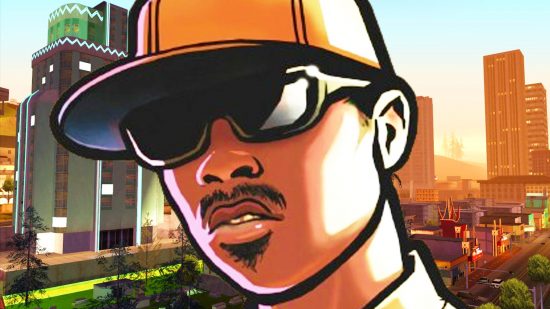There are a lot of reasons to be excited about Grand Theft Auto 6. The return to Vice City. Continuing the story from GTA 5. Finally finding out first-hand what Rockstar has been working on since the launch of Red Dead Redemption 2. But I’m also looking forward to the oddities, eccentricities, and the strange sandbox game surrealism that’s bound to be buried inside GTA 6. You’ll likely remember the Moon size trick from GTA 3 and Vice City. Likewise, the beating heart inside Grand Theft Auto 4’s Statue of Happiness, and the ghosts haunting various spots around Los Santos. Now, one former Rockstar developer lifts the lid on one of the weirdest random moments in GTA San Andreas.
The GTA 6 release date is on the way, providing ample opportunity to recall and reminisce some of the greatest moments from Rockstar’s open-world game series. Originally released back in 2004, Grand Theft Auto San Andreas is perhaps the most spooky and mysterious entry to date. For years, rumors abounded of a possible sasquatch living in the woods of Flint County. The ominously named Panopticon was a hotbed of seemingly supernatural activity, thanks to the driverless ‘ghost cars’ that would spontaneously spawn and roll menacingly towards CJ. There was one errant, buggy jump scare however that never failed to land – or, taken another way, failed to land literally every time.
You’re walking down the street in downtown Los Santos, or maybe the Las Venturas Strip, when suddenly you hear a huge explosion just above your head. Before you can react, the wreckage of a plane lands right by your feet – or in other, less fortunate cases, directly on top of you. Crashing planes were a strange recurrence in GTA San Andreas. One former Rockstar developer, whose credits include GTA 3, Vice City, and of course SA itself, finally opens up on these mystery disasters.

“In GTA San Andreas, small planes are periodically created near the player to perform a fly-by,” Obbe Vermeij, who also worked on GTA 4, Manhunt, and Grand Theft Auto Chinatown Wars explains. “Sometimes they crash. Before creating the plane, my code looks for obstacles in its path. It scans a number of lines in the forward direction of the plane. These scans are slow so I used the absolute minimum, just the body and wingtips I believe. This is why thin obstacles are sometimes not detected.
“In addition, the planes would sometimes lose some height right after being created because their initial speed may not have generated enough lift. There was an additional problem when map models were not streamed in yet. Their collision would be loaded after the plane had already been created. These issues would occasionally allow planes to be created on a doomed flightpath.”
Vermeij says that they were aware of the crashes and considered removing the atmosphere-building flybys from San Andreas altogether. However, they remained in the final game, creating one of the most memorable moments of spontaneous chaos in GTA history. Responding to Vermeij, ‘Silent,’ the famed Grand Theft Auto modder and creator of the bug-fixing ‘Silent Patch,’ explains there is also a bug in the flyby code.

“These planes also crash more than they should due to a bug in the collision detection as planes are spawned,” Silent explains. “This can result in a false positive where the planes spawn, thinking the path in front is clear when in reality, it’s not.”
So, twenty years later, that’s another Grand Theft Auto San Andreas myth busted. But many remain. What’s the deal with the Epsilon Program? Is Bigfoot really out there, hidden in the game’s files under some pseudonymic NPC or asset designation? And why is it so hard to follow the damn train? We’ll just have to keep digging.
In the meantime, check out GTA DB for everything you need to know about Grand Theft Auto 6 including maps, cars, characters, and more. Alternatively, you might want to try some of the best sandbox games available right now on PC.
You can also follow us on Google News for daily PC games news, reviews, and guides, or grab our PCGN deals tracker to net yourself some bargains.
